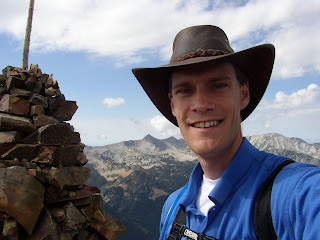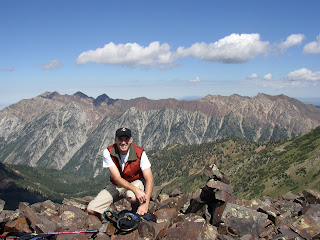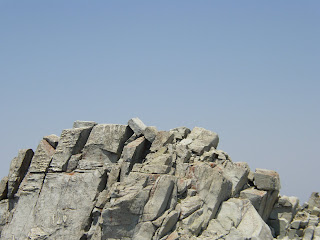 ce my assault on Red Baldy, I thought I better get another 1 - or 2 - down. I couldn’t get anyone to go with me for this hike, so I was on my own.
ce my assault on Red Baldy, I thought I better get another 1 - or 2 - down. I couldn’t get anyone to go with me for this hike, so I was on my own.Having never looked for the Cardiff Pass trail head before, it took me a little time to figure out where to start from. One book I have said to park just East of the Alta Fire Station and to walk down .1 of a mile to a paved road where the trail starts. I did this, but there was no paved road after .1 or .2 of a mile. I tried to get information by stopping in the informatio
 n center (located on the east side of the fire station) but they couldn’t help.
n center (located on the east side of the fire station) but they couldn’t help.Finally I decided to continue walking down the main road and after about .26 of a mile I came to a paved road that came in from the north. I figured out that I think the Alta Fire Station the book was referring to was the old fire station because there looked to be a
 n old fire station looking building where the road came in. For future reference, park next to the Mile post 12 sign and walk down the road for about .1 of a mile until you see the paved road come in from the north.
n old fire station looking building where the road came in. For future reference, park next to the Mile post 12 sign and walk down the road for about .1 of a mile until you see the paved road come in from the north.The paved road splits - take the road that heads right (or east), as the left fork goes to a house. The paved road winds around a building and turns into a dirt road. The dirt road switches back again and then an ATV road comes in from the left (the main dirt road continues straight). Take the ATV track to the left.
At about 9000 feet, a trail breaks off the ATV road. Take it. The trail will eventually reconnect with the road (not sure if it’s the same one) which you will once again follow until about 9300 feet. This is where a trail again breaks off from the main road on the left (north). The trail heads north about 10 yards, then crosses the road you were just on because the road switched back, and then continues on the other side of the road. The trail heads
 parallel to the power lines overhead but stays to the south of them at first.
parallel to the power lines overhead but stays to the south of them at first.The trail climbs at a steeper grade here and after a little while splits. Both ways end up at the same place so it really doesn’t matter which one you take. They both take you to a pretty little meadow with small pine forests mixed in. From here, if you look up to the ridge, you can see a power pole on top of the ridge. This is Cardiff Pass - what we are aiming for.
Once on top of the ridge at about 10,000 feet, turn left (west) and start for Superior first. The first big summit you see (which has some sort of weather station on it) is most easily bypassed on the north side, although a faint trail also leads around the south side towards a cave. I took the south route on the way up and the north (recommended) route on the way back.

Once past this summit, the trail stays for the most part on the south side of the ridge, sometimes 50-100 feet below it. I made the mistake of staying too close to the ridge which made the going harder and in some places more technical than I was comfortable with.
You’ll bypass another minor summit on the south and then come to a small spur ridge (barely noticeable) off of Superior’s south east side. The final 400 or so feet to the top are Class 3, sometimes maybe low class 4 due to poor route finding (personal experience). Before I started the climb, I left my trekking poles so I could use my hands for hand holds on some of the more difficult spots.

I came upon Superior’s summit much faster than I expected and looked over toward Monte Cristo and the large Cairn that marks it’s summit. The ridge between Superior and Monte Cristo is much easier than the ridge you have to negotiate before Superior.
The route is obvious, but you start by descending about 50 feet or so, continuing on towards Monte Cristo on level ground - at one point even coming to a pretty little grassy area which was a very welcome sight since all I had been hiking on for a while was rocks - and then finally coming to the final climb.
The final climb is relatively tame. It is about a 60 foot climb which was easier than most of the stuff I had already done.
I reached the summit and enjoyed the views of the many peaks on the ridge to the south. Also beautiful was the wilderness down to the north of the peak. I have never ventured into that area yet, but pan to do so next year.

After snapping some pictures, eating some crackers and calling my wife, I headed back down because some afternoon thunderstorms looked like they were starting to develop. On my way back to Superior, I spotted a hiker coming up to Superior from the South ridge. We talked briefly on Superior’s summit. He said that it was class 4 or 5, which is a bit out of my league at the moment. He left the summit for Monte Cristo, and I headed back down also.
Not long after I left Superior’s summit, I saw a small brown fox running from the trail down into some small pine
 trees. Other than one very sketchy spot that required a class 4 move, the descent went good and I was back to the car much faster than it took me to go up.
trees. Other than one very sketchy spot that required a class 4 move, the descent went good and I was back to the car much faster than it took me to go up.This hike, although not nearly as physically demanding as Box Elder or Lone Peak’s south summit, was way more technically challenging. It is definitely not for those scared of heights as much of the trail is narrow while hugging a big rock on one side with not much but air on the other.
In total, the hike was 5.5 miles and took me 4 hours and 20 minutes to complete.






































